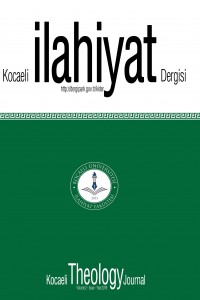Öz
Abstract
The Quran, with its magnificent verse, affected its addressees in
the age of nuzul. This kalam, which has a unique structure admired by even the
enemies of Islam, is being translated into different languages while losing
its effect more or less. Because the translation is to move away from the
original and not be able to express it completely. However, using the
possibilities of the target language during translation, the effect of the
original text for the target audience can be felt, if not completely. For this,
first of all, the source language should be well known, and besides, it should
have a literary knowledge to push the limits of the target language. Our
national poet Mehmet Akif Ersoy (d. 1355/1936) has set a good example in his era
on how to make an effective translation with the meal he wrote. Instead of
stating the meaning of the word, it meant the meaning meant and tried to convey
these meanings to Turkish, which is the target language, in a plain,
understandable and literary way according to the language structure of the
period. The aim of this study is to show that the meaning of Akif is an
effective translation activity. For this, we will focus on how the textual
sentences in the Quran are translated into Turkish by Akif. In this way, both
the strength of the source language and its power at the point of translating
them into Turkish will be revealed.
Anahtar Kelimeler
Tafser Quran Translations Translation Problems Stressed Sentences Akif's Quran Translation
Kaynakça
- Atîk, Abdülaziz. ‛İlmu’l-me‛ânî. Beyrut: Dâru’n-Nahdati’l-‛Arabiyye, 1. Basım, 1430/2009.
- Aydar, Hidayet. “Mehmet Âkif ve Kur’an-ı Kerim Tercümesi”. Diyanet İlmi Dergi 32/1 (Ocak-Şubat-Mart 1996), 43-56.
- Cündioğlu, Dücane. Bir Kur’an Şairi. İstanbul: Kapı Yayınları, 7. Basım, 2017.
- Direnen Meal Akif Meali. ed. Recep Şentürk. İstanbul: Mahya Yayınları, 1. Basım, 2016.
- Ersoy, Mehmet Akif. Safahat. İstanbul: İFAV Yayınları, 1. Basım, 1987.
- Hasan, Abbas. en-Nahvu’l-vâfî. 4 Cilt. Beyrut: Dâru’l-Me‛ârif, 15. Basım, ts.
- Hâşimî, Ahmed b. İbrahim b. Mustafa. Cevâhiru’l-belâğa fi’l-me‛ânî ve’l-beyâni ve’l-bedî‛. Beyrut: el-Mektebetü’l-‛Asriyye, 1. Basım, ts.
- İbn Hişâm, Ebû Muhammed Abdullah b. Yûsuf b. Ahmed Cemâluddîn. Evdahu’l-mesâlik ilâ Elfiyeti İbn Mâlik. thk. Yûsuf Muhammed el-Bikâ‛î. 4 Cilt. Beyrut: Dâru’l-Fikr, 1. Basım, ts.
- Kazvînî, Ebu’l-Me‛âlî Muhammed b. Abdirrahmân b. Ömer Celâluddîn. el-Îdâh fî ‛ulûmi’l-belâğa. thk. Muhammed Abdülmun‛in Hafâcî. 3 Cilt. Beyrut: Dâru’l-Cîl, 3. Basım, ts.
- Kur’an Meali. haz. Recep Şentürk – Âsım Cüneyd Köksal. çev. Mehmed Âkif Ersoy. İstanbul: Mahya Yayınları, 3. Basım, 2013.
- Sabbân, Ebu’l-‛İrfân Muhammed b. Ali eş-Şâfi‛î. Hâşiyetü’s-Sabbân ‛alâ şerhi’l-Eşmûnî li Elfiyeti İbni Mâlik. 3 Cilt. Beyrut: Dâru’l-Kütübi’l-‛İlmiyye, 1. Basım, 1417/1997.
- Sekkâkî, Ebû Ya‛kûb Yûsuf b. Ebî Bekir b. Muhammed b. Ali. Miftâhu’l-‛ulûm. Beyrut: Dâru’l-Kütübi’l-‛İlmiyye, 2. Basım, 1407/1987.
- Tansel, Fevziye Abdullah. Mehmet Akif Ersoy. İstanbul: y.y.,1973.
- Uluçay, Mustafa. “Akif’in Kur’an Meali’nde Dil ve Üslûp Özellikleri”. Türk Dili ve Edebiyatı Dergisi 50/50 (Ocak 2014), 121-135.
Öz
Kur’an-ı Kerim, harikulade nazmıyla nüzul çağındaki muhataplarını tesiri altına almıştır. İslam düşmanlarının bile hayranlıkla itiraf ettiği eşsiz bir yapıya sahip olan bu kelam farklı dillere çevrilirken bu etkisini az ya da çok yitirmektedir. Zira çeviri, asıldan uzaklaşmak ve onu bütünüyle ifade edememektir. Bununla birlikte çeviri esnasında hedef dilin olanakları kullanılarak hedef kitle için orijinal metnin etkisi, bütünüyle olmasa da hissettirilebilir. Bunun için öncelikle kaynak dil iyi bilinmeli ve bunun yanında hedef dilin imkân sınırlarını zorlayacak bir edebiyat bilgisine sahip olunmalıdır. Milli şairimiz Mehmet Akif Ersoy (ö. 1355/1936) yazmış olduğu mealle etkili bir tercümenin nasıl yapılması gerektiğine dair kendi döneminde güzel bir örneklik teşkil etmiştir. Lafza bağlı kalıp manayı ıskalamaktansa kastedilen anlamı öncelemiş ve hedef dil olan Türkçeye bu anlamları dönemin dil yapısına göre gayet sade, anlaşılır ve edebi olarak aktarmaya çalışmıştır. Bu çalışmanın amacı Akif’in mealinin etkili bir tercüme faaliyeti olduğunu göstermektir. Bunun için Kur’an-ı Kerim’deki tekitli cümlelerin Akif tarafından Türkçeye nasıl kazandırıldığı üzerine yoğunlaşılacaktır. Böylelikle Akif’in hem kaynak dile vukufiyeti hem de bunları Türkçeye aktarım noktasındaki gücü ortaya konulmuş olacaktır.
Anahtar Kelimeler
Tefsir Kur'an Tercümeleri Tercüme Problemleri Tekitli Cümleler Akif'in Meali
Kaynakça
- Atîk, Abdülaziz. ‛İlmu’l-me‛ânî. Beyrut: Dâru’n-Nahdati’l-‛Arabiyye, 1. Basım, 1430/2009.
- Aydar, Hidayet. “Mehmet Âkif ve Kur’an-ı Kerim Tercümesi”. Diyanet İlmi Dergi 32/1 (Ocak-Şubat-Mart 1996), 43-56.
- Cündioğlu, Dücane. Bir Kur’an Şairi. İstanbul: Kapı Yayınları, 7. Basım, 2017.
- Direnen Meal Akif Meali. ed. Recep Şentürk. İstanbul: Mahya Yayınları, 1. Basım, 2016.
- Ersoy, Mehmet Akif. Safahat. İstanbul: İFAV Yayınları, 1. Basım, 1987.
- Hasan, Abbas. en-Nahvu’l-vâfî. 4 Cilt. Beyrut: Dâru’l-Me‛ârif, 15. Basım, ts.
- Hâşimî, Ahmed b. İbrahim b. Mustafa. Cevâhiru’l-belâğa fi’l-me‛ânî ve’l-beyâni ve’l-bedî‛. Beyrut: el-Mektebetü’l-‛Asriyye, 1. Basım, ts.
- İbn Hişâm, Ebû Muhammed Abdullah b. Yûsuf b. Ahmed Cemâluddîn. Evdahu’l-mesâlik ilâ Elfiyeti İbn Mâlik. thk. Yûsuf Muhammed el-Bikâ‛î. 4 Cilt. Beyrut: Dâru’l-Fikr, 1. Basım, ts.
- Kazvînî, Ebu’l-Me‛âlî Muhammed b. Abdirrahmân b. Ömer Celâluddîn. el-Îdâh fî ‛ulûmi’l-belâğa. thk. Muhammed Abdülmun‛in Hafâcî. 3 Cilt. Beyrut: Dâru’l-Cîl, 3. Basım, ts.
- Kur’an Meali. haz. Recep Şentürk – Âsım Cüneyd Köksal. çev. Mehmed Âkif Ersoy. İstanbul: Mahya Yayınları, 3. Basım, 2013.
- Sabbân, Ebu’l-‛İrfân Muhammed b. Ali eş-Şâfi‛î. Hâşiyetü’s-Sabbân ‛alâ şerhi’l-Eşmûnî li Elfiyeti İbni Mâlik. 3 Cilt. Beyrut: Dâru’l-Kütübi’l-‛İlmiyye, 1. Basım, 1417/1997.
- Sekkâkî, Ebû Ya‛kûb Yûsuf b. Ebî Bekir b. Muhammed b. Ali. Miftâhu’l-‛ulûm. Beyrut: Dâru’l-Kütübi’l-‛İlmiyye, 2. Basım, 1407/1987.
- Tansel, Fevziye Abdullah. Mehmet Akif Ersoy. İstanbul: y.y.,1973.
- Uluçay, Mustafa. “Akif’in Kur’an Meali’nde Dil ve Üslûp Özellikleri”. Türk Dili ve Edebiyatı Dergisi 50/50 (Ocak 2014), 121-135.
Ayrıntılar
| Birincil Dil | Türkçe |
|---|---|
| Bölüm | Makaleler |
| Yazarlar | |
| Yayımlanma Tarihi | 26 Haziran 2020 |
| Kabul Tarihi | 10 Haziran 2020 |
| Yayımlandığı Sayı | Yıl 2020 Cilt: 4 Sayı: 1 |
![]()
Kocaeli İlahiyat Dergisi Creative Commons Atıf-GayriTicari 4.0 Uluslararası Lisansı ile lisanslanmıştır.
Kocaeli Journal of Theology is licensed under a Creative Commons Attribution-NonCommercial 4.0 International Licence.


